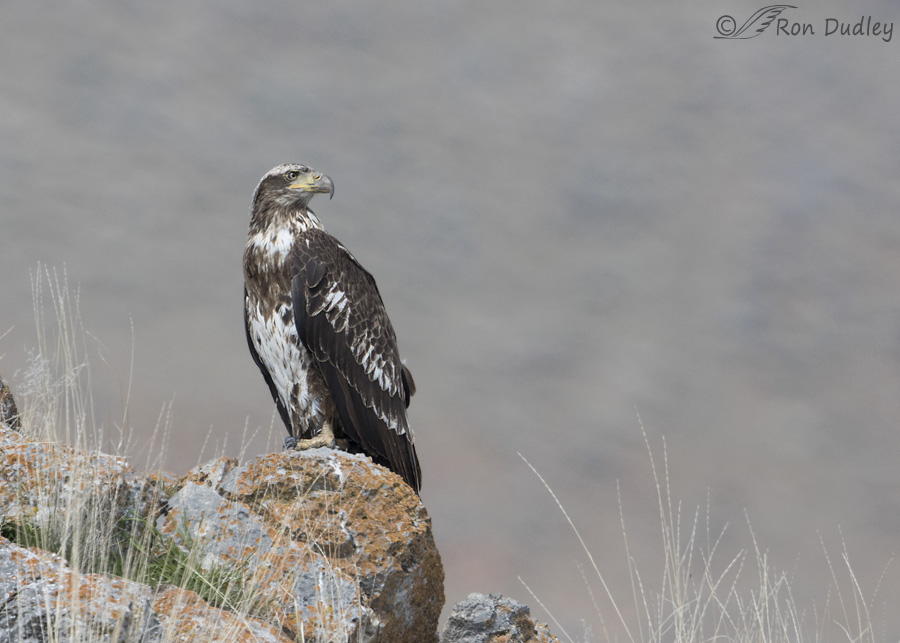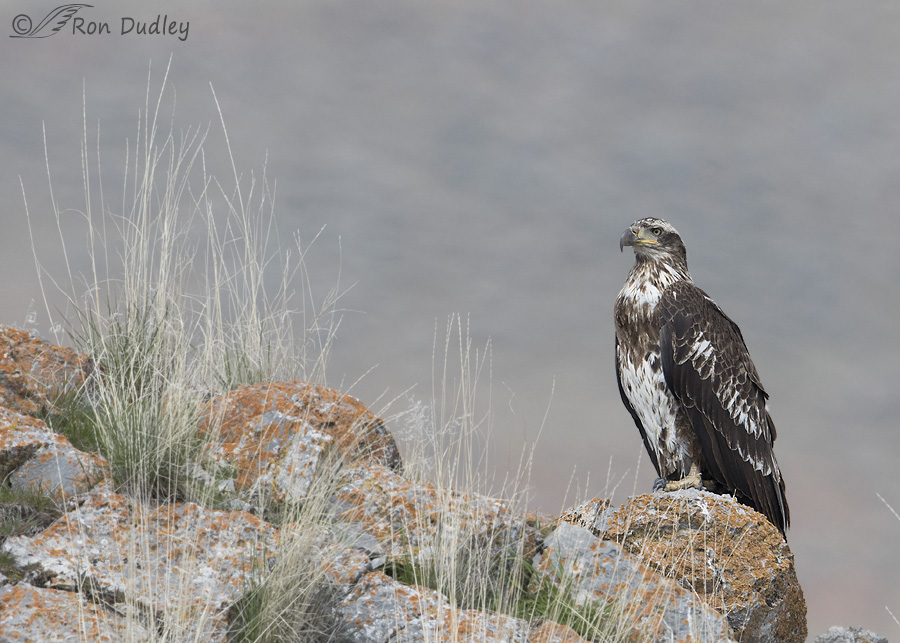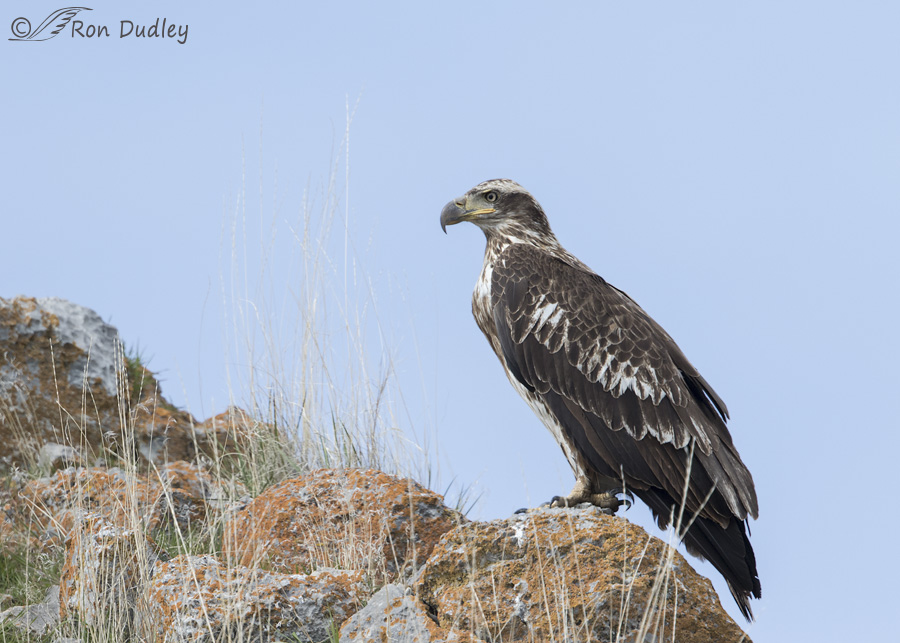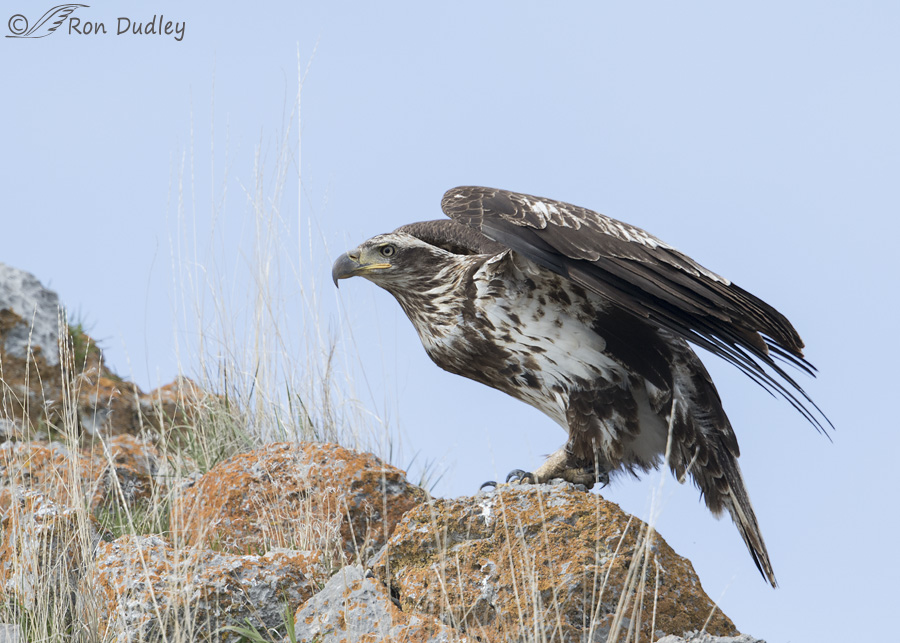Differing crops of similar photos can have a major impact on the “feel” of the images.

1/1600, f/7.1, ISO 500, Canon 7D Mark II, Canon EF 500mm f/4L IS II USM + EF 1.4 III Extender, not baited, set up or called in
I photographed this sub-adult Bald Eagle this past April on the east side of Utah’s Promontory Mountains. As I came around a curve in the road the bird was on a rocky, sloping outcrop directly in front of me. I don’t see Bald Eagles in the area often and those few I do see are usually skittish and unapproachable and I fully expected this one to fly off immediately but it surprised me by posing for some time. A cloud was passing over so the light was flat but with the mountains in the background instead of bright sky I think the image works.
When the eagle glanced over its shoulder it allowed me to crop the image so that the bird was looking into open space. In this composition we see relatively few rocks and mostly out-of-focus mountainside in the background so the image has a relatively clean look.

1/1600, f/7.1, ISO 500, Canon 7D Mark II, Canon EF 500mm f/4L IS II USM + EF 1.4 III Extender, not baited, set up or called in
But usually the eagle was facing forward so I had to crop to include many rocks and grasses. The lichen-covered boulders appeal to me partly because I rarely see Bald Eagles in this type of habitat.
The eagle was very patient with me but eventually I had to drive down the road which meant I’d get much closer to the eagle and likely flush it.

1/1250, f/7.1, ISO 500, Canon 7D Mark II, Canon EF 500mm f/4L IS II USM + EF 1.4 III Extender, not baited, set up or called in
But I was amazed when the bird stuck. With bright sky behind the shaded eagle I don’t like the light in these final two images but I include them for their detail (I was quite close to the bird so this photo is cropped very little – it’s 80% of the original image).

1/1000, f/7.1, ISO 500, Canon 7D Mark II, Canon EF 500mm f/4L IS II USM + EF 1.4 III Extender, not baited, set up or called in
At this close range when the bird did eventually take off I was much too close to keep it all in frame.
I’m always slightly surprised to see Bald Eagles in this area but as evidenced by the bulging crop of this bird these migrating eagles are getting plenty to eat. I suspect the attraction might be the multitude of road-killed rabbits in the vicinity.
Ron


I’m fascinated by the coloration. And the beak looks somehow too large–as if it hasn’t quite grown into itself.
To me, any bald or golden eagle shot is a good one! And these are fantastic! I agree that the lichen, the mottled background of the mountain and the eagle’s coloration combine to provide a lot of texture and visual appeal. I also like the last two shots — for me, there’s something incredibly special in seeing an eagle against a bright blue sky.
And these are fantastic! I agree that the lichen, the mottled background of the mountain and the eagle’s coloration combine to provide a lot of texture and visual appeal. I also like the last two shots — for me, there’s something incredibly special in seeing an eagle against a bright blue sky.
I especially appreciate your describing her age. That’s how I found your blog originally — I followed a link from the DC eagle cam chat to your series on bald eagle development and was hooked!
Marty, Over time that post, A Guide To Aging Bald Eagles, has had more views, by far, than any other single post I’ve published.
It was a fascinating post — I knew that there were several stages, but didn’t realize how many. I’m hoping Mr. P and TFL will return to their nest again.
WHAT a beak. And gaze.
I love the implicit tension and power in the last.
Thank you, EC.
Isn’t White Chested the proper term? Heard that used several times.
I’m confused, Steven. The proper term for what?
Eagle under 5
One and two year old Bald Eagles do have a conspicuous white belly so perhaps that’s what you’re referring to.
Two year old female?
Probably.
Love sub adult balds better than adults. They’re coloration is so interesting. I’m guessing it’s a female??? Size and beak?? I have balds in the desert but never more than a few miles from the river. Like the setting very much. Im finding A perfect bird picture has to have a perfect background. You always seem to nail it.
“Im finding A perfect bird picture has to have a perfect background”
I certainly wouldn’t dispute that, Marina. Backgrounds are extremely important to a pleasing/interesting image.
Love that second-to- last image ; the eagle is parallel to the diagonal of the lichen-covered boulder , so even though the bird is quiet, the whole composition has a dynamic quality.
Interesting point, Kris. I hadn’t even noticed that.
Again, just lovely. I love the play of color with the lichen against the sky and the eagle. Bald eagles have such huge beaks! Just another perspective.
Just another perspective.
Don’t forget that road kill is food, too. Imagine what would happen without scavengers and free food is free food! My rule for road kill is that it’s got to be a head shot and fresh–not all skoozy
“Skoozy” – now there’s a word that when applied to road kill brings some interesting images my mind, Laura!
Skoozy means the road kill has passed into fine Vulture dining
Luv it!
How wonderful to see a Bald Eagle! Seeing one is always exciting. I love the perch with all the lichens and grasses, and the mountains make a nice background. I think my favorite shot is the last one, though, because I like the action and the coloration details.
Most any day when a Bald Eagle is seen is a good one, Susan!
Beautiful images and a good tutorial on who the crop/composition changes things. Glad there are more of them. They are scavengers for sure so you may be right on the road kill being an attraction. We see them on road kill dear frequently along with the crows and ever present magpies.
Glad there are more of them. They are scavengers for sure so you may be right on the road kill being an attraction. We see them on road kill dear frequently along with the crows and ever present magpies. 
Judy, this area is jackrabbit-rich and I suspect locals don’t lose much sleep when they hit one while driving, especially at night. Vultures and magpies are the most common scavengers on the dead rabbits though the occasional Golden Eagle dines on them too.
Wonderful Ron!
charlotte
Thanks, Charlotte.
Beautiful images Ron. Thank you again for sharing your insights and technique.
I appreciate that feedback, John.